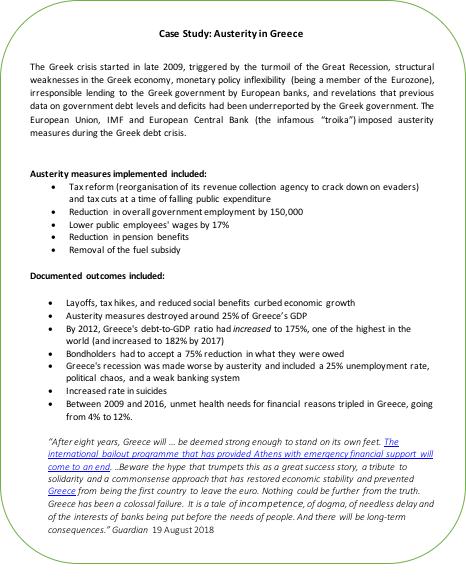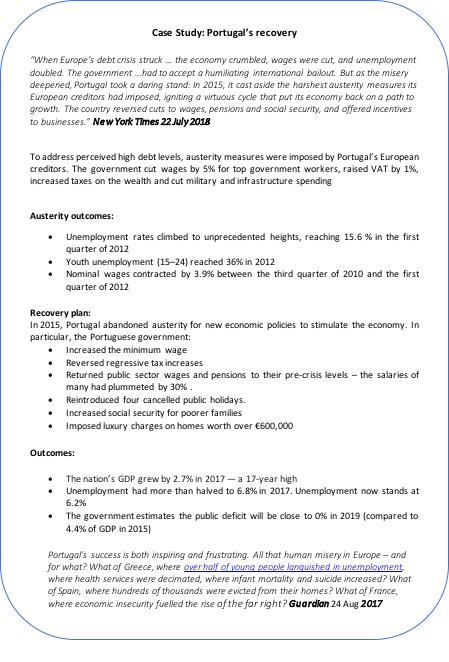BUSINESS MAVERICK: OP-ED
If SA wants to emulate the Portuguese success and avoid the Greek disaster, we must stop full-blown austerity

Unless a major shift has happened and this austerity plan abandoned, the proposed approach will have disastrous implications for our economy, and plunge us into recession, if not a deep economic depression similar to the 2008/9 economic crisis.
“What’s very clear is that austerity, which we in some parts of the G20 thought was absolutely necessary… is no longer the answer. In South Africa, as well, we have some austerity fans amongst our public commentators and its time to rethink.” — Pravin Gordhan, Minister of Finance 2016. Reuters 26 July 2016
The state may have to implement “surgical and difficult austerity measures” — Deputy President David Mabuza address to the annual Nedlac conference in Johannesburg. Fin 24 September 14 2018
NB: In Part 2 we will look at alternatives to austerity.
In a previous Daily Maverick article, I argued that South Africa needs a three-pronged package of systemic change if we are to emerge from the current crisis. This package is summed up in three terms: stabilise, stimulate, and structurally transform.
- Stabilise: includes measures to support and stabilise most depressed and marginalised communities and crisis-hit industries
- Stimulate: requires a macroeconomic stimulus package — monetary, fiscal, and investment measures — to get the wheels of the economy turning.
- Structurally transform: requires measures to diversify and industrialise our economy.
Integral to this is the need to expand public spending and inject new funds into the economy. Through this, economic stagnation, rising debt levels and declining revenue can be arrested by increasing demand and expanding production.
The logic of austerity — cuts to government expenditure and/or regressive tax increases during periods of the economic downturn in order to reduce debt levels — runs in the opposite direction.
Austerity is defended on one or both of the premises that high debt levels have a negative impact on growth by “crowding out” private sector investment, and that public spending cuts drive down interest rates and this stimulates higher private sector investment. It also assumes that cuts to government spending have a relatively little adverse effect on aggregate demand.
All of these assumptions are false. There is no credible evidence that a particular level of debt is growth-retarding, interest rates do not appear to be sensitive to demand for funds in this way, and public sector cuts do considerable damage.
This is now becoming the economic consensus, including among international organisations such as the IMF.
The international experience of austerity
In October 2012, the IMF announced that its forecasts for countries that implemented austerity programmes have been consistently overoptimistic, suggesting that tax hikes and spending cuts have been doing more damage than expected, and countries that implemented fiscal stimulus did better than expected.
The IMF reported that this was due to “fiscal multipliers” being considerably larger than predicted. Previously it had estimated these at around 0.5 — meaning a 1% reduction in spending would lead to a direct contraction in GDP of 0.5%. However, it updated this research with data from 28 countries to show that these actually ranged between 0.9 and 1.7. In other words, a 1% reduction in government spending would reduce GDP between 0.9% and 1.7%.
Global experience is therefore that fiscal consolidation has not led to lower debt-to-GDP ratios because austerity has led to a contraction in GDP. This relationship was effectively conceded in the 2017 MTBPS:
“Over the past four years, the government has followed a path of measured fiscal consolidation, aiming to stabilise the debt to GDP ratio by reducing spending and introducing tax increases. But debt has continued to rise as a share of GDP as economic growth rates have declined.”
The experience of Greece and Portugal


If South Africa wants to emulate the Portuguese success story, and avoid the Greek economic disaster, we must stop the descent into full-blown austerity, and relook at our macro-economic strategies. The Portuguese experience has been one of the success stories which helped to shift Europe away from austerity policies. It would be tragic if SA fully embraced austerity at a time when Europe and some other parts of the world are moving away from austerity; and at a time when anti-austerity protests are exploding in response to austerity’s destructive effects globally, in places such as Chile, Lebanon, France and elsewhere.
The implications of fiscal austerity for South Africa
The adoptions of austerity budgets have damaging impacts for broadly two different reasons.
First, when budget allocations are slashed, then citizens who rely on public services — particularly working class and the poor, and disproportionately women — suffer from the reduction of these services in particular areas, such as lack of clinics, medicines, health workers; or shortages of teachers, equipment and classrooms.
Second, fiscal policy (together with monetary policy) perform the function of stabilising or stimulating demand in the economy, particularly in periods of economic contraction or stagnation. In some societies this has been treated as more of a cyclical role and stimulus is cut back in times of rapid economic expansion.
However, in a society such as South Africa – ravaged by unemployment, poverty and underdevelopment, the need for stimulus is even greater. The structural factors underpinning economic underperformance require sustained co-ordination of macro-economic interventions to close the “output gap” which reflects the gap between the actual and potential performance of the economy. Fiscal policy is an important part of the toolbox to address this challenge.
The impact of ‘mild austerity’ thus far
After an initial stimulus in 2008 and 2009 in the wake of the global financial crisis, growth in government spending was curtailed from 2010, gradually limiting spending increase to population growth — therefore effectively meaning that there has been no real increase in spending per capita for most of the past nine years. This can be called “moderate austerity” as spending cuts were relatively limited.
This, however, began to change since 2016, when real spending cuts were instituted. Even before 2016, spending cuts were deeper than the table below suggests, as rising real public sector wages were not accommodated by rising allocations, and other unanticipated expenses rose, including the bailouts of SOEs, meaning that real cuts were instituted in other areas.

Another feature of this period was the squeezing out of infrastructure spending, as a result of cutbacks, which led to a collapse in government investment spending. This was combined with the collapse of SOE investment spending in part as a result of rampant State Capture:
Growth in government and state-owned company investment compared to private investment

Calculated from Statistics South Africa. ‘GDP P0441 — 2019 Q2’. Source: TIPs POLICY BRIEF: 2/2019 The National Treasury economic policy discussion paper.
Impact of austerity on health
Section 27 of the Constitution of South Africa states that access to healthcare is a basic human right which must be enjoyed by everyone.
Public health spending has increased significantly since 1994 and the government has made progress in improving access to healthcare. Overall outcomes in areas such as infant and maternal mortality have improved and after a disastrous period of delay and denialism by government, the HIV/AIDS programme has expanded exponentially. However, the public healthcare system remains severely overstretched and underfunded.
Recent years have seen significant budget cuts, leading to vacant posts and declining standards in many parts of the health system. In May 2018, the Treatment Action Campaign (TAC) reported that 38,217 posts were not filled. Although central to primary health care, around 60 000 community healthcare workers are informally employed and reliant on a paltry stipend with poor equipment and training.
Over the past five years, the rate of growth of health expenditure per uninsured person has slowed and in 2016/17, was actually reduced. When inflation and population growth are accounted for, per capita healthcare spending has stalled. This despite the NHI White Paper recognising that expenditure will have to double if quality healthcare is to be provided to all. Shortfalls in funding have delayed the implementation of the NHI. To meet those financial obligations which are hardest to avoid, such as wages, operational health budgets are cut or invoices simply unpaid.
In the 2016 Life Esidimeni tragedy, 143 mentally ill patients lost their lives after being transferred to a group of unprepared and under-resourced NGOs. The arbitration found the need to cut costs was a red herring excuse used by departmental officials attempting to avoid accountability for their bad decision-making.
However, such disasters are more likely to occur in an under-resourced health system where budgets are constantly strained, than in one where departments have sufficient resources. Furthermore, there is an exponentially rising burden of medico-legal claims (from R28.6-billion in 2015 to R80.4-billion in 2018) faced by departments of health, exacerbated by chronic underfunding and staffing shortages, which lead to service failures.
Impact of austerity on basic education
Section 29 (1)(a) of the Constitution — Everyone has the right to basic education, including adult education.
South Africa has made strides in addressing the highly unequal education system inherited from apartheid, where it was key in driving segregation and inequality. South Africa has achieved gender parity in school enrolment. The number of learners who passed matric increased from 50% in 1994 to 78% in 2018. The current curriculum is universally applied to all, creating a harmonised education system. However, in 2016 Progress in International Reading Literacy Study (PIRLS) has revealed that after four years of schooling, 78% of South African learners cannot read for meaning which compares poorly with the international average of 4%. Grade 4 children in South Africa scored the lowest of the 50 countries participating in this test.
The austerity measures adopted by the government in recent years are exacerbating this poor performance. The amount spent on basic education has been decreasing steadily over the past five years. The share of total expenditure has declined from 20.9% in 2013 to 14.4% in 2019 and increases in expenditure have been either below inflation (in 2014/15, 2015/16 and 2018/19) or marginally above inflation. Spending per learner has been steadily decreasing for years, largely unnoticed — it fell in real terms from R17,822 in 2010 to R16,435 in 2017. It has declined by 10% since 2010 because allocations made do not account for the increase in birth rates (between 2003 and 2008) and increased school enrolment in public schools. Also, per capita personnel compensation has been increasing at a rate above inflation, while the increases in government spending are not keeping up with personnel costs.
Cuts include spending on essential infrastructure. The Education Infrastructure Grant (EIG) provides co-funding for the ongoing infrastructure programme in provinces, including the maintenance of existing infrastructure and the building of new infrastructure. Aside from the large increase in 2015/16, funding has been steadily decreasing since 2016/17. In 2018/19, funding dropped by 8.3%. This is because of the R 3.6-billion Cabinet-approved reduction of the grant in 2018 for the following three years. Learners have died in pit toilets due to lack of adequate sanitation in schools. In 2014, Michael Komape drowned in a full pit toilet and again in 2018 Lumka Mtetwa died in a pit toilet.
Austerity cuts are also impacting the ability to provide education to particularly vulnerable groups of learners. This is the case for learners with disabilities. In November 2015 there were as many as 182,153 children with disabilities in KwaZulu-Natal, but 137,889 (76%) were not receiving any schooling and the special schools are under-resourced.
Should we expect further austerity in the MTBPS?
The micro-detail of the MTBPS will be analysed ad nauseam in the days to come. What is important is not to lose sight of the big picture.
We can and will debate the size and impact of the cuts planned over the next three years, but if Treasury’s announcements are to be believed we are going into a far more serious austerity mode.
In late August Treasury leaked plans to cut expenditure by 5%,6%, and 7% respectively over the next three years. These drastic proposed cuts were contained in Treasury’s fiscal guidelines given to departments and provinces. Some reports suggest that these cuts will take place in the baseline only once projected growth (from the previous MTBPS) is factored in. So there may not be the magnitude of cuts to existing spending which these figures suggest. But this is speculation only about the degree of cuts.
Several fiscal scenarios were presented to the government, according to reports. The scenario presented by Treasury proposed R326-billion cuts over three years, and spending subsequently capped at below the level of revenue. This also proposed a 10-12% across-the-board reduction of the wage bill (two-thirds of the cuts); a reduction in university bursaries and subsidies; and no above-inflation increases for social grants.
Unless a major shift has happened, and this austerity plan abandoned, the proposed approach will have disastrous implications for our economy, and plunge us into recession, if not a deep economic depression similar to the 2008/9 economic crisis.
It is clear that cuts will take place to wages, filling of frontline vacancies, infrastructure, and investment in public services. As various commentators have stated, the government will be forced to look to these areas as they can’t cut social grants, debt service payments, transfers to SOEs in crisis, or obligations to existing public servants (except through attrition and early retirement packages.)
If as now seems inevitable, an austerity package is announced in the MTBPS, the real discussion that has to take place in civil society is how in the run-up to the 2020 budget we can reverse this reckless and damaging austerity framework before it is too late.
We need an urgent national engagement in which different views on these matters are seriously considered. The minister’s approach that only views within National Treasury’s paradigm will be entertained is highly unfortunate, and can only end in disastrous mistakes which could haunt generations to come. DM
This article draws on work done by Busi Sibeko, IEJ researcher, for an international literature review on austerity and its dangers. This research will shortly be released as an educational booklet, to assist with discussions around the MTBPS and the national budget.
Neil Coleman’s twitter handle is @NeilColemanSA


















 Become an Insider
Become an Insider